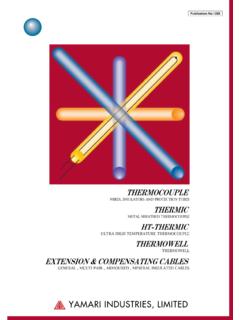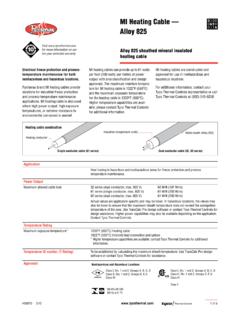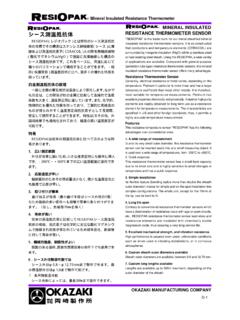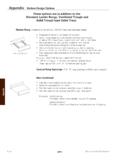Transcription of Session 13 –Wiring Methods & Cable Standards
1 Session 13 Wiring Methods & Cable StandardsMulticorecables on racks or trays may be bunched in a maximum of two and LV single core cables shall be laid in trefoil groups with 150 mm clear spacingbetween trays or racks HV cables shall be segregated from the LV cables. Individual cables emerging from floors or soil shall be protected against mechanical damage by means of galvanized steel pipes or rigid PVC pipes. Single core cables emerging from floors or soil shall be protected by rigid PVC pipes. These pipes shall extend at least 100 mm above ground or floor cables emerging from floors or soil shall be protected collectively by a properly designed metal shield or duct in such a way that heat dissipation of the sustained load carrying cables is not hampered. The propagation of fire from one space to the other shall be prevented by proper sealing of openings around or Cable supports shall not be fixed directly or indirectly to plant, equipment or process piping which may require removal or replacement.
2 Cables shall be laid on racks or trays strictly in accordance with the laying patterns stated on the layout drawings. Metal parts of the Cable racks and trays shall be bonded and connected to the common IEC Wiring SpecificationTypical IEC Wiring SpecificationBends and corners in the Cable racks, trays or ladders shall take account of the minimum Cable bending radii. Cable racks and trays shall be closed by removable top covers, allowing adequate ventilation, in situations where: mechanical damage of the cables is likely to occur during plant maintenance activities, oil or chemical spillages on the trays can be expected, sun shielding is required against direct solar Cable rack risers shall not be installed in front of, or over, pipe cablingThe application of flexible cables in industrial plants and installations shall be limited to: welding cables; trailing cables, for movable equipment, hand tools, hand lamps; winches, hoists, soot blowers, and electric motors, if connected by means of a nearby intermediate junction earth continuity conductor, equal in cross sectional area to the largest phase conductor, shall be provided.
3 This requirement applies even when the Cable is IEC Wiring SpecificationCable marking/numberingCable numbers shall be marked on the cables along their routes and at both termination points. For underground cabling, the spacing between Cable numbers along the route should not exceed 5 m, and for above ground cabling, 25 m. Cables shall also be numbered where they branch off from a main underground Cable marking purposes non corroding strips shall be used, each having ample length to be wrapped twice around the Cable and in which the Cable number has been imprinted by means of letter/cipher punches. For above ground cabling, plastic markers resistant to the site conditions shall be strapped round the underground cabling, above ground route markers shall also be provided at every change of direction in the routing and at both sides of road or pipeline crossings, except when Cable routing is already indicated by colored concrete Installation MethodsConduit or Cable Entry via EEx e gland & enclosureDirect Entry via EEx d conduitDirect Entry via EEx d glandTypical Wiring MethodsRigid ConduitUnarmoredCableArmoredCableIEC Cable Types and ConstructionUnarmored Cable similar to US TC type cables but with fully extruded fillers.
4 Armored Cable similar in concept to IEEE45 Type P marine shipboard Cable and continuous corrugated aluminum armor SWA Steel Wire ArmorType STA Steel Tape ArmorType SWB Steel Wire BraidThe following main requirements are listed in the EN60079 standard for cables and conductors: use only insulated cables and conductors (test voltage 500 VAC), in special cases earth the required screening only once at the end of the non explosive environment, protect intrinsically safe circuits against external electrical or magnetic fields through the maintenance of adequate distances, screening and/or core twisting, isolate intrinsically safe cables and conductors from non intrinsically safe cables and conductors or, protect against mechanical damage or, protect through metal housing, or screening of the cables and conductors do not combine conductors of intrinsically safe and non intrinsicallysafe circuits prevent the fraying of fine wired conductors through the use of Cable sleeves, for example.
5 Isolate intrinsically safe and non intrinsically safe circuits in Cable bundles or ducts via insulation spacer or an earthed metal spacer (not required with screening or sheathing), identify ( light blue) the cables and conductors of intrinsically safe circuits (not required with shielding or metal sheathing) Cable /Conductor Requirements in Zone applicationsWhen selecting cables and conductors, only use those which can withstand the expected mechanical, chemical and thermal influences. Cables and conductors with thermoplastic sheath, duroplasticsheath, elastomersheath or mineral insulation with metal sheath may be used for fixed routing. Cable branch lines must comply with the requirements for hazardous cables and conductors must be connected to the electrical equipment in line with the directives for the associated type of protection. Unused openings on devices and equipment must be closed. When cables and conductors are installed through openings into non hazardous areas, care must be taken to provide an adequate seal at the openings ( sand filling, mortar) to prevent carrying over of the zone.
6 At particularlyhazardous points, cables and conductors must be protected against thermal, mechanical or chemical stress by, for example, conduits, tubing or covers. The flame retardanceof cables and conductors for fixed routing must be proven in accordance with IEC 60332 Requirements in Zone applicationsIEC Cable Types and ConstructionIn general, SWA Cable has been the Cable of choice in the UK for onshore installations. It is somewhat flexible, readily available and has good bending Cable has become the choice for installations offshore with various armor materials including tinned copper, bronze and other materials. Very flexible yet durable under very demanding conditions. Many different jacket types is more of an onshore type Cable and is widely used in onshore applications in continental Europe, especially for power applications. Clients have started to shy away from STA as it is generally regarded as slightly more difficult to terminate than either SWA or variation commonly used for direct bury applications is a Lead sheathed armor Cable .
7 Lead provides a very good insulation due to corrosive elements and is particularly resistant to rodents and ants. Cable glands for lead sheathed Cable typically need an additional component to seat the lead portion of the on glands is to mark a XZ for braid and tape, with a W for wire armor for field & RFOU instrumentation cables are manufactured with either overall or individual screens, the cores are either laid up as pairs or triples. Ideal for signal and instrumentation circuits where the fire performance and Low Smoke Zero Halogen properties are increasingly being required within public buildings and power stations, as well as traditional Petro/Chemindustries. The Cable is designed to carry on working for a period of 3 hours when exposed to fire, according to IEC 60331 test procedure. BFOU also offers good screening properties, reducing Electro Magnetic Interference (EMI).ConstructionTinned stranded copper conductor, MICA tape, EPR insulation, overall screen of Copper backed Polyester tape with a stranded copper drain wire , inner sheath of Halogen Free ThermosetElastomer, tinned copper wire braid and an outer sheath of Halogen Free ThermosetElastomer.
8 The individually screened version has a Copper backed Polyester tape with a stranded copper drain wire around each pair or colorsPairs Light blue, blackTriples Light blue, black and brownEach pair or triple is identified by a numbered Cable Types and ConstructionThe most common sheath material for data cabling in use in the UK is PVC. For many environments, PVC is the ideal material, having superior mechanical characteristics and high reliability. However, in a fire, PVC emits heavy black smoke mixed with hydrochloric acid, thus reducing vision, immediately impairing breathing, and additionally initiating corrosion of all equipment exposed to the fumes. For improved fire performance, it is common for LSZH Low Smoke Zero Halogen (usually meeting IEC61034, IEC60754 2 and IEC60332 3) Cable sheaths to be used within major Standards in common use are shown in the Cable Types and ConstructionIEC Cable Tests for Fire ApplicationsTypical IEC Cable TestsFire Resistant Test IEC60331 21 Under long fire exposure, the Cable must maintain the power supply for vital safety equipment (emergency lighting, alarm, systems & fire pumps, etc.)
9 Smoke Density Test IEC61034 1/2 The smoke density test evaluates the smoke emissions of the Cable and the jacket under fire condition IEC60332 3 Flame retardant test simulating cables installed in bunch on a vertical ladder under fire 1 2 Single wire or Cable Atestonasinglelengthofcable600mm long held between 2clamps. The flame is applied for apredetermined amount of timebased on the weight of thecable. Topassthetestthereshouldnotbe any visible damage orcharring within 50mm of thelower edge of the top clamp(Equalto425mmhigherthantheflame source) once allcombustionhasstopped. This test replaces IEC60332 1,BS4066pt1&BSEN50265 2 3 The ladder test The IEC60332 3 ranges of tests are conductedonbunchesofcablesandaremuchclos ertoareal life installation. Lengths of cablesare bunched onto a Cable ladder in a chimneysimulatingabuildingriser. The volume of Cable on the ladder isdeterminedinlitresofcombustiblemateria ltoofferabalancedviewofperformanceacross acablerange.
10 Aflameisapplied500mmfromthebaseoftheladd er for a predetermined time. When theburnerhasextinguishedaone hourafter burnperiod is allowed then the cables are checkedforperformance. To pass the tests the cables should not beaffected by the flame above the 3 categoriesTest Qty of material Flame application Supersedes 60332 3 22 Cat A litres40 minutes IEC60332 3A BS4066 pt 3A60332 3 23 Cat B litres40 minutesIEC60332 3B BS4066 pt 3 BIEC60332 3 24 Cat C litres20 minutesIEC60332 3 CBS4066 pt 3 CIEC60332 3 25 Cat D litres 20 minutes60332 3 21 Cat A F/R Used for large cables instead of 3 22 Cat A . The cables are mounted on the front and back of the ladder All these tests are to be conducted on complete cables. Compounds alone cannot be tested to IEC60332 Fire Resistant Testing Widely used in commercial/public buildings & MOG applications to controlfirealarm/monitoring systems, emergency lighting, fire shutters and emergency Fire Standards Standard requirement IEC60331 Cables 3 hours at 750 C (1970 edition) IEC60331 21 Cables 90 minutes @ 750 C (unless alt.)







